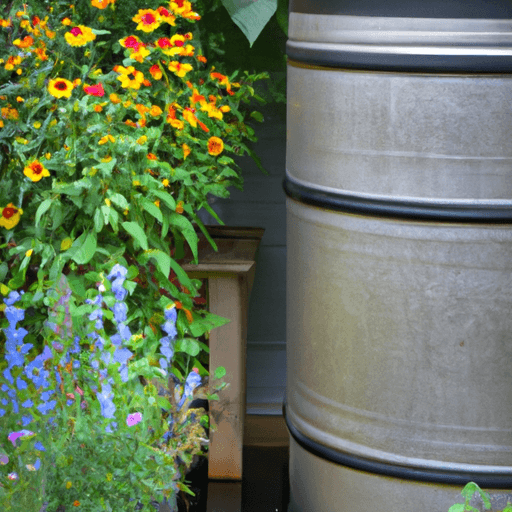Rainwater harvesting is an age-old practice that has been gaining popularity in recent years as a sustainable solution to water scarcity. It involves collecting and storing rainwater for later use, rather than allowing it to run off into the ground or rivers.
The environmental importance of rainwater harvesting cannot be overstated, particularly in regions that face frequent droughts and dwindling groundwater supplies. Rainwater harvesting not only provides an additional source of water but also helps in reducing pressure on existing sources such as lakes, rivers, and underground aquifers.
This can lead to improved water quality and increased availability of freshwater for both human consumption and agricultural purposes. Furthermore, by capturing rainwater before it hits the ground, we reduce soil erosion and minimize flooding which ultimately benefits our ecosystem.
In this article, we will explore the environmental significance of rainwater harvesting while highlighting some of its advantages over traditional methods of water supply management.
Overview Of Rainwater Harvesting
Rainwater harvesting is a process of collecting and storing rainwater for future use. This practice has been in existence since ancient times, but it gained significant importance with the growing need to conserve water resources due to population growth and climate change.
Rainwater can be collected from rooftops, roads, or other surfaces and stored in tanks or underground reservoirs. Properly designed systems can collect large amounts of water that would otherwise go to waste.
The benefits of rainwater harvesting are numerous, including reducing demand on groundwater sources, decreasing storm runoff and erosion, improving soil quality, and providing an alternative source of water for non-potable uses such as irrigation and industrial processes.
Additionally, rainwater harvesting can help alleviate flooding in urban areas by reducing the amount of surface runoff during heavy rainfall events. The implementation of rainwater harvesting system can also contribute to sustainable development goals by promoting self-sufficiency in local communities while protecting natural resources.
Benefits Of Rainwater Harvesting
Rainwater harvesting offers several benefits to the environment.
Firstly, it helps in reducing water runoff and soil erosion thereby conserving natural resources like groundwater and topsoil.
Secondly, it provides an additional source of clean water that can be used for non-potable purposes such as watering plants or flushing toilets.
Furthermore, rainwater harvesting systems can also help mitigate urban heat island effects by increasing green spaces within cities which absorb rainfall and reduce temperatures.
Additionally, since harvested rainwater is free from chemicals commonly found in tap water like chlorine, it is a healthier alternative for household uses like laundry and bathing.
These benefits make rainwater harvesting an attractive option for sustainable development and environmental conservation efforts worldwide.
Moving on to practical considerations for rainwater harvesting, there are several factors that need to be taken into account when designing and implementing a system.
Practical Considerations For Rainwater Harvesting
In order to effectively harvest rainwater, certain practical considerations must be taken into account.
Firstly, the location of the harvesting system should be carefully chosen in accordance with local zoning and building codes.
The size of the catchment area must also correspond to the amount of rainfall received in a given region.
Secondly, it is important to consider the type of roofing material used for collection.
Materials such as asphalt shingles or metal roofing may contain chemicals that can contaminate collected water.
It is recommended to use non-toxic materials such as clay tiles, slate, or coated steel when constructing a roof for rainwater harvesting purposes.
Additionally, proper maintenance and cleaning procedures must be put in place to ensure that the harvested water remains free from debris and pollutants.
Overall, successful rainwater harvesting involves careful planning and consideration of various factors including location, catchment area size, roofing material selection, and maintenance practices.
By adopting these best practices, individuals can contribute towards sustainable water management while enjoying numerous benefits ranging from reduced reliance on municipal water supplies to lower utility bills.
Rainwater harvesting is a centuries-old practice that involves collecting and storing rainwater for later use. In recent years, the importance of this traditional technique has been re-discovered due to its environmental benefits.
Rainwater harvesting helps to reduce our reliance on groundwater resources, which are becoming increasingly scarce in many parts of the world. It also reduces stormwater runoff, which can cause soil erosion and water pollution.
Moreover, rainwater harvesting is an effective way to conserve water and reduce water bills. Harvested rainwater can be used for a variety of purposes such as irrigation, flushing toilets, washing clothes and cars, or even for drinking after proper treatment. This not only saves money but also conserves valuable freshwater resources.
However, there are practical considerations that need to be taken into account when implementing rainwater harvesting systems. These include factors such as rainfall patterns, roof size and material quality, storage capacity, filtration methods and maintenance requirements. Proper design and installation can help ensure efficient collection and safe storage of rainwater.
In conclusion, rainwater harvesting is an environmentally friendly solution that provides numerous benefits including reducing dependence on groundwater sources, mitigating stormwater runoff, saving money on water bills while conserving freshwater resources. With proper planning and implementation practices put in place, we could all contribute towards preserving natural resources by adopting this age-old tradition once again in today’s modern context.

